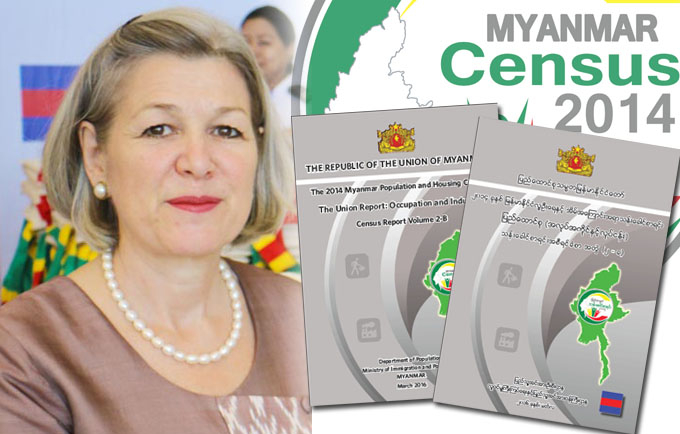Excellencies, ladies and gentlemen,
Today, with the release of census data on occupation and industry, we mark another milestone in Myanmar’s historic 2014 census exercise. The new figures offer important insights into how Myanmar can strengthen its economy and promote social equity.
On behalf of UNFPA, the United Nations Population Fund, I offer my heartfelt congratulations to the Government of Myanmar, and in particular the Department of Population in the Ministry of Immigration and Population, for their continuous commitment to carrying out census activities. This dedication has enabled DOP to release the main results in record time. By way of comparison, even some of the most advanced countries take three to five years before releasing census data.
This is the third stage of census data release, following preliminary findings in August 2014 and the main results launch last May. The new data on occupation and industry are based on handwritten responses which had to be captured semi-manually, a process that took more than 10 months.
The wealth of information provided so far by the first census in 30 years has already proven invaluable. Health and education ministries are using the results to reorient policies and plan for more effective interventions in areas where social indicators are the lowest. Humanitarian agencies used localized population data to effectively target their responses to last year’s widespread flooding emergency.
When it takes office just a few days away from now, Myanmar’s new Government will be able to set development priorities based on reliable information about the country’s people and their social needs. Incoming government leaders and parliamentarians have already shown a keen interest in learning about the census results and their potential use.
The information on occupation and industry released today enormously amplifies our understanding of working realities in Myanmar and in the economic sectors that employ the largest numbers of people. For the first time, we have the numbers to reveal patterns of work not just for the general working-age population, but also specifically for children, young people, the elderly, and the disabled. The new data also illuminate striking differences between men and women’s access to work.
Some of the findings have important policy implications. Notably, 21 per cent of children aged 10-17 in Myanmar go to work instead of going to school. These 1.6 million children are missing out on the education that could lead to better jobs and employment security when they grow up. Myanmar’s youthful population puts the country on the verge of an economic boom, a phenomenon known as the “demographic dividend”. This potential can only be realized, however, if the country invests in its children and young people and provides adequate opportunities for training and productive work.
As a further indication of the need for national labour policies promoting investment in jobs for young people, the census report finds that 9.3 per cent of people in Myanmar between ages 15 and 24 are unemployed, a rate more than double the 4 per cent unemployment among those aged 15-64. Young women are more likely to be unemployed than young men (9.5 per cent versus 9.1 per cent).
The new report reveals also profound gender disparities in paid employment. Just half of all women who could work are actually earning income for themselves and their families. Work in the home rests overwhelmingly on the shoulders of women, with 38.8% of females doing household work compared to 1.2% of males. Only 50.5 per cent of women aged 15-64 are economically active (those either working or looking for a job) compared to 85.2 per cent of men. Twenty-six per cent of women work without pay as “contributing family workers”, compared to 11 per cent of men. The fact that a quarter of the productive population does not contribute directly to the economy implies that Myanmar could reap a significant “gender dividend” if economic opportunities for women were increased.
The latest census results show that more than 50 per cent of employed men and women are working in agriculture, forestry or fishing. Women are disproportionately represented in service sectors like food and accommodation. Sectors like mining and quarrying that generate lots of revenue employ only about 1 per cent of the working population overall and a smaller share of women.
More-detailed, complementary information on the workforce is expected soon, when the Ministry of Labour releases the findings of a Labour Force Survey it conducted with support from the International Labour Organization. This relied on the sampling frame of the census to select a sufficiently large, representative sample of the national population to survey. Participants answered multiple questions on various aspects of the labour force. The results will provide estimates at the union and state/region levels and for urban and rural populations. The census, in contrast, included just three labour questions but covered all households, and provides data down to the lowest administrative level.
The 2014 Population and Housing Census has been a hallmark of Myanmar’s reform process, and offers an instrumental contribution to the work ahead. The census findings, including those presented here, provide invaluable opportunities for the next Government to respond to the needs of the people in Myanmar, including the most vulnerable. The data can inform new policies to create safety nets that will promote gender equity, allow young people to stay in school, and enable the elderly, the disabled and other marginalized groups to access supportive services.
UNFPA is proud of our support to Myanmar and the DOP in conducting and analysing this important census, and we look forward to continuing our assistance in the next phases of the exercise: thematic reports that will shed further light on needs that the country must address as the reform goes forward.
Thank you.

